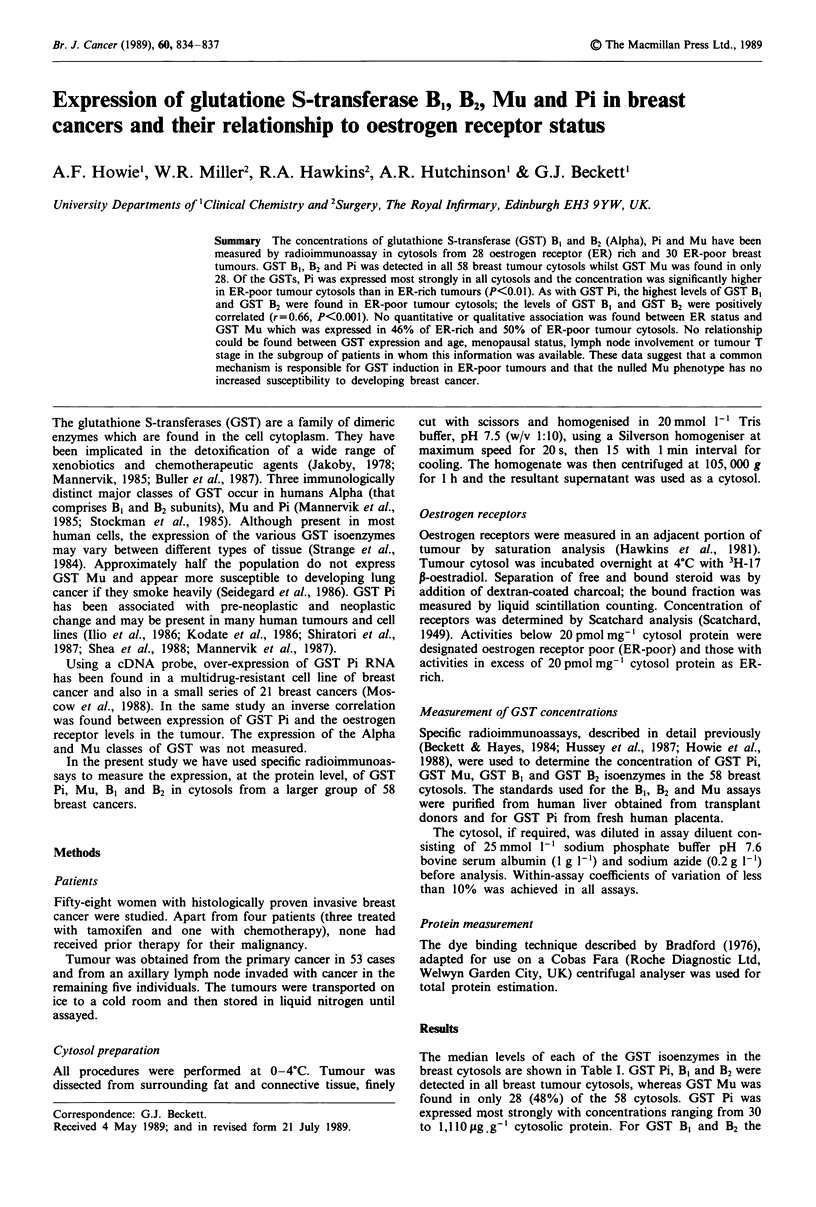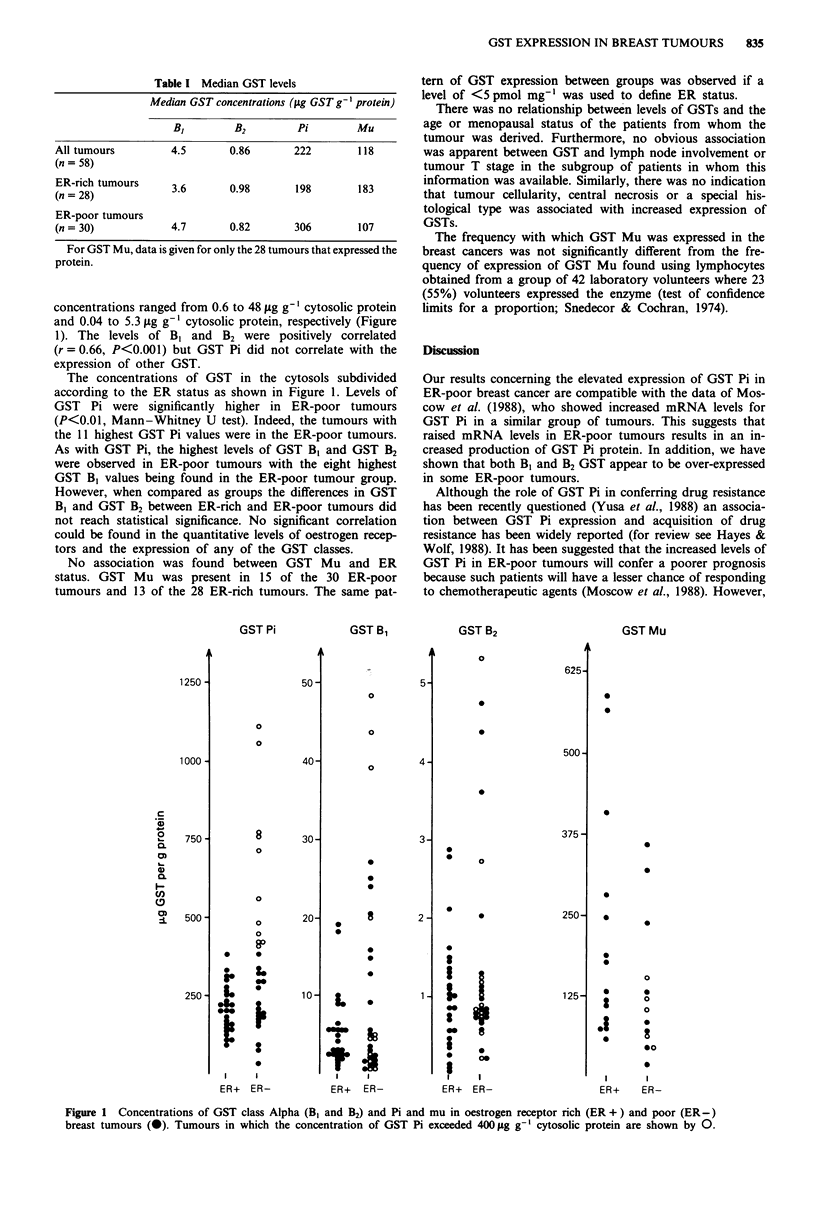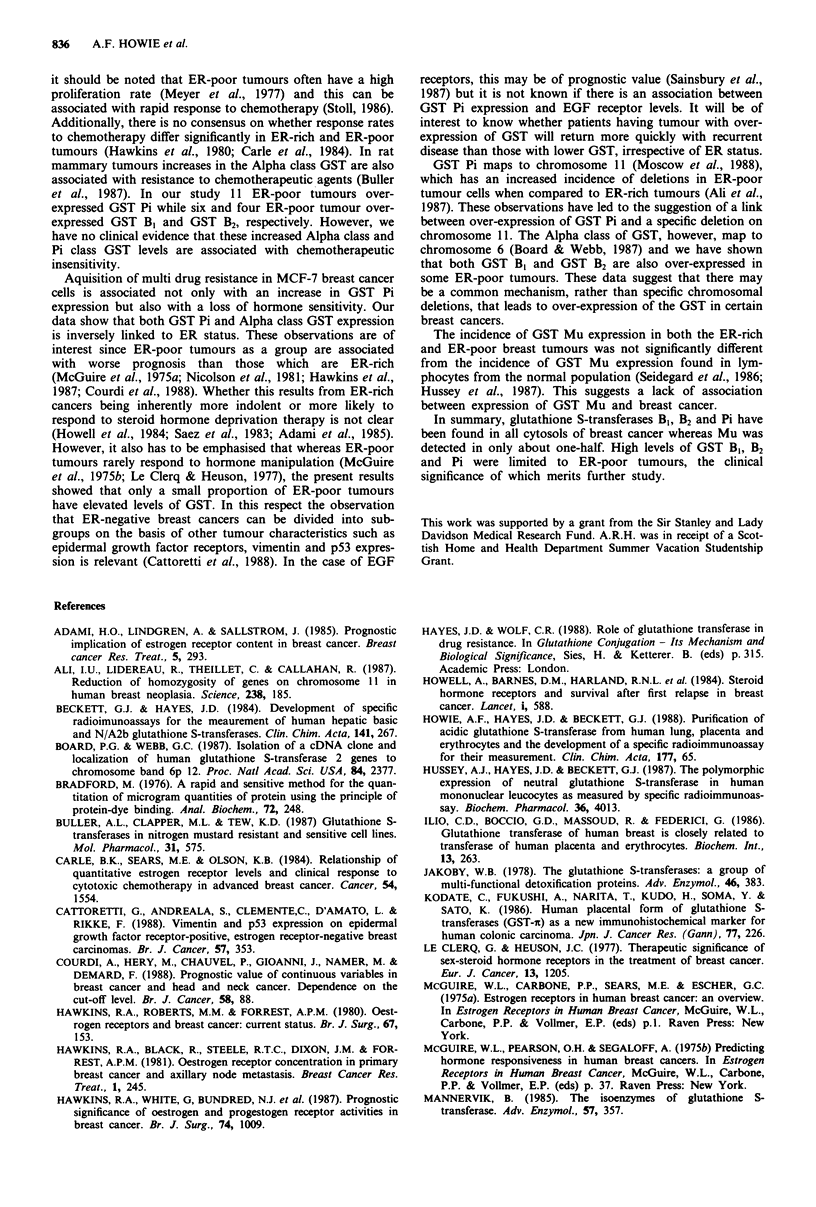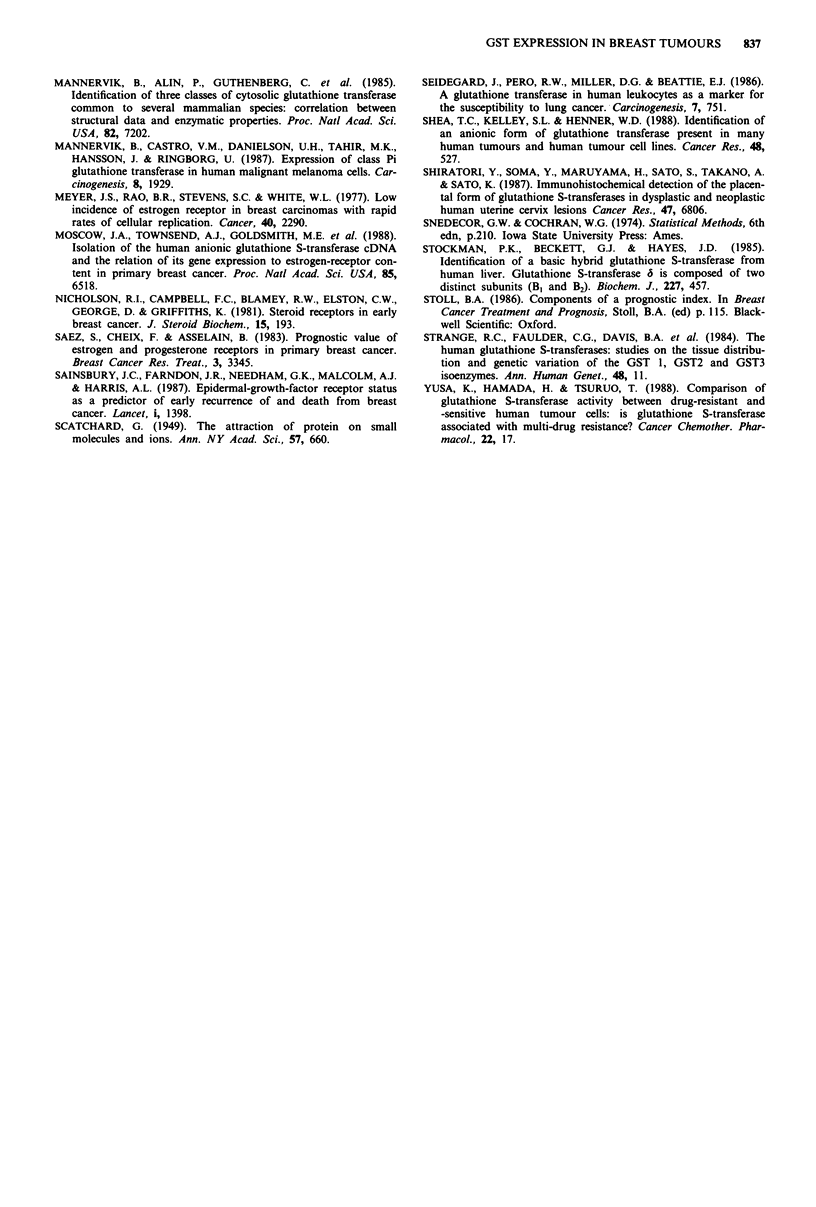Abstract
The concentrations of glutathione S-transferase (GST) B1 and B2 (Alpha), Pi and Mu have been measured by radioimmunoassay in cytosols from 28 oestrogen receptor (ER) rich an 30 ER-poor breast tumours. GST B1, B2 and Pi was detected in all 58 breast tumour cytosols whilst GST Mu was found in only 28. Of the GSTs, Pi was expressed most strongly in all cytosols and the concentration was significantly higher in ER-poor tumour cytosols than in ER-rich tumours (P less than 0.01). As with GST Pi, the highest levels of GST B1 and GST B2 were found in ER-poor tumour cytosols; the levels of GST B1 and GST B2 were positively correlated (r = 0.66, P less than 0.001). No quantitative or qualitative association was found between ER status and GST Mu which was expressed in 46% of ER-rich and 50% of ER-poor tumour cytosols. No relationship could be found between GST expression and age, menopausal status, lymph node involvement or tumour T stage in the subgroup of patients in whom this information was available. These data suggest that a common mechanism is responsible for GST induction in ER-poor tumours and that the nulled Mu phenotype has no increased susceptibility to developing breast cancer.
Full text
PDF



Selected References
These references are in PubMed. This may not be the complete list of references from this article.
- Adami H. O., Graffman S., Lindgren A., Sällström J. Prognostic implication of estrogen receptor content in breast cancer. Breast Cancer Res Treat. 1985;5(3):293–300. doi: 10.1007/BF01806024. [DOI] [PubMed] [Google Scholar]
- Ali I. U., Lidereau R., Theillet C., Callahan R. Reduction to homozygosity of genes on chromosome 11 in human breast neoplasia. Science. 1987 Oct 9;238(4824):185–188. doi: 10.1126/science.3659909. [DOI] [PubMed] [Google Scholar]
- Beckett G. J., Hayes J. D. Development of specific radioimmunoassays for the measurement of human hepatic basic and N/A2b glutathione S-transferases. Clin Chim Acta. 1984 Aug 31;141(2-3):267–273. doi: 10.1016/0009-8981(84)90020-2. [DOI] [PubMed] [Google Scholar]
- Board P. G., Webb G. C. Isolation of a cDNA clone and localization of human glutathione S-transferase 2 genes to chromosome band 6p12. Proc Natl Acad Sci U S A. 1987 Apr;84(8):2377–2381. doi: 10.1073/pnas.84.8.2377. [DOI] [PMC free article] [PubMed] [Google Scholar]
- Bradford M. M. A rapid and sensitive method for the quantitation of microgram quantities of protein utilizing the principle of protein-dye binding. Anal Biochem. 1976 May 7;72:248–254. doi: 10.1016/0003-2697(76)90527-3. [DOI] [PubMed] [Google Scholar]
- Buller A. L., Clapper M. L., Tew K. D. Glutathione S-transferases in nitrogen mustard-resistant and -sensitive cell lines. Mol Pharmacol. 1987 Jun;31(6):575–578. [PubMed] [Google Scholar]
- Cattoretti G., Andreola S., Clemente C., D'Amato L., Rilke F. Vimentin and p53 expression on epidermal growth factor receptor-positive, oestrogen receptor-negative breast carcinomas. Br J Cancer. 1988 Apr;57(4):353–357. doi: 10.1038/bjc.1988.81. [DOI] [PMC free article] [PubMed] [Google Scholar]
- Corle D. K., Sears M. E., Olson K. B. Relationship of quantitative estrogen-receptor level and clinical response to cytotoxic chemotherapy in advanced breast cancer. An extramural analysis. Cancer. 1984 Oct 15;54(8):1554–1561. doi: 10.1002/1097-0142(19841015)54:8<1554::aid-cncr2820540815>3.0.co;2-4. [DOI] [PubMed] [Google Scholar]
- Courdi A., Héry M., Chauvel P., Gioanni J., Namer M., Demard F. Prognostic value of continuous variables in breast cancer and head and neck cancer. Dependence on the cut-off level. Br J Cancer. 1988 Jul;58(1):88–90. doi: 10.1038/bjc.1988.169. [DOI] [PMC free article] [PubMed] [Google Scholar]
- Di Ilio C., Del Boccio G., Massoud R., Federici G. Glutathione transferase of human breast is closely related to transferase of human placenta and erythrocytes. Biochem Int. 1986 Aug;13(2):263–269. [PubMed] [Google Scholar]
- Hawkins R. A., Black R., Steele R. J., Dixon J. M., Forrest A. P. Oestrogen receptor concentration in primary breast cancer and axillary node metastases. Breast Cancer Res Treat. 1981;1(3):245–251. doi: 10.1007/BF01806264. [DOI] [PubMed] [Google Scholar]
- Hawkins R. A., Roberts M. M., Forrest A. P. Oestrogen receptors and breast cancer: current status. Br J Surg. 1980 Mar;67(3):153–169. doi: 10.1002/bjs.1800670302. [DOI] [PubMed] [Google Scholar]
- Hawkins R. A., White G., Bundred N. J., Dixon J. M., Miller W. R., Stewart H. J., Forrest A. P. Prognostic significance of oestrogen and progestogen receptor activities in breast cancer. Br J Surg. 1987 Nov;74(11):1009–1013. doi: 10.1002/bjs.1800741118. [DOI] [PubMed] [Google Scholar]
- Howell A., Barnes D. M., Harland R. N., Redford J., Bramwell V. H., Wilkinson M. J., Swindell R., Crowther D., Sellwood R. A. Steroid-hormone receptors and survival after first relapse in breast cancer. Lancet. 1984 Mar 17;1(8377):588–591. doi: 10.1016/s0140-6736(84)90995-4. [DOI] [PubMed] [Google Scholar]
- Howie A. F., Hayes J. D., Beckett G. J. Purification of acidic glutathione S-transferases from human lung, placenta and erythrocyte and the development of a specific radioimmunoassay for their measurement. Clin Chim Acta. 1988 Sep 30;177(1):65–75. doi: 10.1016/0009-8981(88)90308-7. [DOI] [PubMed] [Google Scholar]
- Hussey A. J., Hayes J. D., Beckett G. J. The polymorphic expression of neutral glutathione S-transferase in human mononuclear leucocytes as measured by specific radioimmunoassay. Biochem Pharmacol. 1987 Nov 15;36(22):4013–4015. doi: 10.1016/0006-2952(87)90472-2. [DOI] [PubMed] [Google Scholar]
- Jakoby W. B. The glutathione S-transferases: a group of multifunctional detoxification proteins. Adv Enzymol Relat Areas Mol Biol. 1978;46:383–414. doi: 10.1002/9780470122914.ch6. [DOI] [PubMed] [Google Scholar]
- Kodate C., Fukushi A., Narita T., Kudo H., Soma Y., Sato K. Human placental form of glutathione S-transferase (GST-pi) as a new immunohistochemical marker for human colonic carcinoma. Jpn J Cancer Res. 1986 Mar;77(3):226–229. [PubMed] [Google Scholar]
- Leclercq G., Heuson J. C. Therapeutic significance of sex-steroid hormone receptors in the treatment of breast cancer. Eur J Cancer. 1977 Nov;13(11):1205–1215. doi: 10.1016/0014-2964(77)90026-3. [DOI] [PubMed] [Google Scholar]
- Mannervik B., Alin P., Guthenberg C., Jensson H., Tahir M. K., Warholm M., Jörnvall H. Identification of three classes of cytosolic glutathione transferase common to several mammalian species: correlation between structural data and enzymatic properties. Proc Natl Acad Sci U S A. 1985 Nov;82(21):7202–7206. doi: 10.1073/pnas.82.21.7202. [DOI] [PMC free article] [PubMed] [Google Scholar]
- Mannervik B., Castro V. M., Danielson U. H., Tahir M. K., Hansson J., Ringborg U. Expression of class Pi glutathione transferase in human malignant melanoma cells. Carcinogenesis. 1987 Dec;8(12):1929–1932. doi: 10.1093/carcin/8.12.1929. [DOI] [PubMed] [Google Scholar]
- Mannervik B. The isoenzymes of glutathione transferase. Adv Enzymol Relat Areas Mol Biol. 1985;57:357–417. doi: 10.1002/9780470123034.ch5. [DOI] [PubMed] [Google Scholar]
- Meyer J. S., Rao B. R., Stevens S. C., White W. L. Low incidence of estrogen receptor in breast carcinomas with rapid rates of cellular replication. Cancer. 1977 Nov;40(5):2290–2298. doi: 10.1002/1097-0142(197711)40:5<2290::aid-cncr2820400541>3.0.co;2-t. [DOI] [PubMed] [Google Scholar]
- Moscow J. A., Townsend A. J., Goldsmith M. E., Whang-Peng J., Vickers P. J., Poisson R., Legault-Poisson S., Myers C. E., Cowan K. H. Isolation of the human anionic glutathione S-transferase cDNA and the relation of its gene expression to estrogen-receptor content in primary breast cancer. Proc Natl Acad Sci U S A. 1988 Sep;85(17):6518–6522. doi: 10.1073/pnas.85.17.6518. [DOI] [PMC free article] [PubMed] [Google Scholar]
- Nicholson R. I., Campbell F. C., Blamey R. W., Elston C. W., George D., Griffiths K. Steroid receptors in early breast cancer: value in prognosis. J Steroid Biochem. 1981 Dec;15:193–199. doi: 10.1016/0022-4731(81)90275-2. [DOI] [PubMed] [Google Scholar]
- Sainsbury J. R., Farndon J. R., Needham G. K., Malcolm A. J., Harris A. L. Epidermal-growth-factor receptor status as predictor of early recurrence of and death from breast cancer. Lancet. 1987 Jun 20;1(8547):1398–1402. doi: 10.1016/s0140-6736(87)90593-9. [DOI] [PubMed] [Google Scholar]
- Seidegård J., Pero R. W., Miller D. G., Beattie E. J. A glutathione transferase in human leukocytes as a marker for the susceptibility to lung cancer. Carcinogenesis. 1986 May;7(5):751–753. doi: 10.1093/carcin/7.5.751. [DOI] [PubMed] [Google Scholar]
- Shea T. C., Kelley S. L., Henner W. D. Identification of an anionic form of glutathione transferase present in many human tumors and human tumor cell lines. Cancer Res. 1988 Feb 1;48(3):527–533. [PubMed] [Google Scholar]
- Shiratori Y., Soma Y., Maruyama H., Sato S., Takano A., Sato K. Immunohistochemical detection of the placental form of glutathione S-transferase in dysplastic and neoplastic human uterine cervix lesions. Cancer Res. 1987 Dec 15;47(24 Pt 1):6806–6809. [PubMed] [Google Scholar]
- Stockman P. K., Beckett G. J., Hayes J. D. Identification of a basic hybrid glutathione S-transferase from human liver. Glutathione S-transferase delta is composed of two distinct subunits (B1 and B2). Biochem J. 1985 Apr 15;227(2):457–465. doi: 10.1042/bj2270457. [DOI] [PMC free article] [PubMed] [Google Scholar]
- Strange R. C., Faulder C. G., Davis B. A., Hume R., Brown J. A., Cotton W., Hopkinson D. A. The human glutathione S-transferases: studies on the tissue distribution and genetic variation of the GST1, GST2 and GST3 isozymes. Ann Hum Genet. 1984 Jan;48(Pt 1):11–20. doi: 10.1111/j.1469-1809.1984.tb00829.x. [DOI] [PubMed] [Google Scholar]
- Yusa K., Hamada H., Tsuruo T. Comparison of glutathione S-transferase activity between drug-resistant and -sensitive human tumor cells: is glutathione S-transferase associated with multidrug resistance? Cancer Chemother Pharmacol. 1988;22(1):17–20. doi: 10.1007/BF00254174. [DOI] [PubMed] [Google Scholar]


